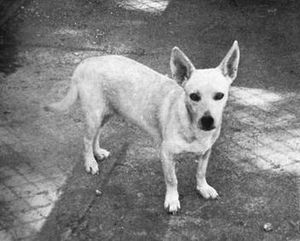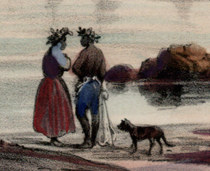Hawaiian Poi Dog facts for kids

Hawaiian Poi Dog (center) in sketch by Louis Choris, c. 1816–17
|
|
| Other names | ʻĪlio, ʻĪlio mākuʻe, Hawaiian Dog |
|---|---|
| Origin | Hawaii (United States) |
| Breed status | Extinct |
| Domestic dog (Canis lupus familiaris) | |
The Hawaiian Poi Dog (called ʻīlio or ʻīlio mākuʻe in Hawaiian) was an extinct breed of dog from Hawaiʻi. Native Hawaiians used these dogs as special protectors for children. They were also a source of food.
Contents
History of the Hawaiian Poi Dog
The first Hawaiian Poi Dogs came from Polynesian dogs. These dogs were brought to the Hawaiian Islands by Polynesian people. Studies on the New Zealand Kurī dog suggest these dogs originally came from Indonesia.
Why They Were Called "Poi Dogs"
In the Hawaiian language, these dogs were called ʻīlio. Their modern name, "poi dog," comes from poi. Poi is a main food in Hawaii, made from kalo or taro root. Poi was used to make the dogs fat for food. Meat was too valuable for people to use as dog food.
Life and Purpose of Poi Dogs
The Hawaiian Islands did not have large wild mammals. So, Poi dogs were not needed for hunting. People did not breed these dogs to look a certain way. However, both humans and nature helped shape the breed.
European explorers like Captain Cook saw these dogs. They were often pot-bellied and short-legged. They also freely mixed with pigs in the villages. The dogs had very short hair that could be any color. Brown poi dogs were special enough to have their own name.
These dogs also had unusually flat heads. This might have been because of their diet. Poi does not need much chewing. So, the dogs might not have needed strong chewing muscles. This could make their heads look flatter. Poi dogs were thought to be a bit slow and lazy. A good hunting dog would not have been useful on the islands. However, these dogs were strong-willed and not easy to command.
Decline of the Breed
The poi dog had two main uses: as food and as a lucky charm. They were not suited for other tasks. The breed slowly disappeared as the native religion changed. Also, eating dog meat became less popular. Wild dogs brought by European settlers bred with the poi dogs. By the early 1900s, the Hawaiian Poi Dog was no longer a distinct breed.
Surviving Depictions of Poi Dogs
It is hard to find true pictures or photos of poi dogs from Hawaiian history. Western artists often drew dogs with European features in the 1700s. By the 1800s, the dogs shown were often foreign breeds. Because of this lack of detail, historians guess which artworks might show real poi dogs. They look for specific physical traits.
Writers Katharine Luomala and Margaret Titcomb agreed on one drawing. It was an unfinished sketch from about 1816–17 by French artist Louis Choris. He was on an expedition with Otto von Kotzebue. They thought the dog in the center of this sketch might look like the extinct breed. Luomala also believed French artist Barthélémy Lauvergne might have drawn a similar dog. This was in his colored drawing of Honolulu Harbor in 1836.
Ancient Hawaiian petroglyphs also show simple drawings of dogs. These often show the curly tails and pointy ears that were common for the breed.
Breeding Program to Recreate the Breed

In 1967, Jack L. Throp, who directed the Honolulu Zoo, tried to bring back the breed. He did this by carefully breeding local dogs. He chose dogs based on how they looked. The project studied descriptions of the dog from the 1700s and 1800s. They also looked at old dog bones to understand the breed's features.
From this research, they picked local dogs in Hawaii. These dogs were then bred to have the desired traits. By the third generation of dogs in the program, a female was born. She had the look of the ancient breed.
In 1969, Throp said:
The Honolulu Zoo started a project in 1967 to bring back the Polynesian dog. The goal is to show the animal life of the Hawaiian Islands in a living Hawaiian exhibit. The dog is an important part of the Polynesians' story.
The program is thought to have stopped soon after this. In 1976, the crew of the Hōkūleʻa brought a dog from this program on their trip. They were recreating an old Polynesian sea voyage between Hawaii and Tahiti. They named the dog Hoku.
Modern Use of "Poi Dog"
Today, the phrase "poi dog" often means a mixed-breed dog. People also use it to describe certain traits of these dogs. These include being able to eat anything, having a strong will, and looking unique because they are a mix of different breeds. The term "poi dog" is also sometimes used to describe people of mixed heritage. However, the more common term for this is hapa.
See also
 In Spanish: Perro Poi hawaiano para niños
In Spanish: Perro Poi hawaiano para niños




